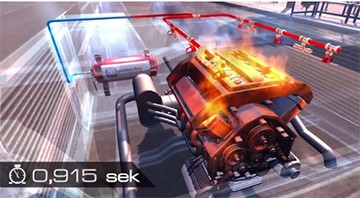Get an ultra-fast fire extinguishing system for buses
Nextech offers a world-leading fire extinguishing system approved for this very purpose: protecfire’s renowned and internationally used detexline system.
The detexline system was originally designed for use in the German mining industry, and has thus been tested and approved under some of the world’s toughest safety requirements. It is characterised by high operational reliability, as it operates 100% mechanically. There is therefore no risk of failure in the event of a power failure or a drop in pressure. In addition, the system stands out with its ultra-fast and efficient extinguishing, which also prevents reignition once extinguishing is complete.
The system is pre-dimensioned and designed for the engine types and engine compartments used in Danish buses today, allowing for quick installation and minimal space consumption.
Installing a detexline fire extinguishing system can also mean that the company will find it easier to obtain a lower risk assessment and profile for the buses in question from the company’s insurer, as the extent of consequential damage is significantly minimised.
Watch the video below to see how the fire protection system for buses works:
What you get with a detexline fire extinguishing system for buses
- Ultra-fast fire protection that is constantly on stand-by and neither dependent on power nor under pressure
- Fire extinguishing system that works for extinguishing various types of fires, including liquid (e.g. diesel oil), dry materials (e.g. rubber, insulation and wiring) and electrical installations
- Fire extinguishing system with 10-year warranty when a service agreement is signed with Nextech
- Fire protection that is not affected by vibrations, impact, shock, or contamination by oil or dirt
- Fire extinguishing system that can be used in geographical areas with temperatures from -30 to +80 degrees
- Tailored fire protection for engines, where detectors of variable sensitivity provide optimal protection in the individual areas of the engine.
> Read more about how the fire protection system works here
We will be happy to visit you without obligation with a demo case so that you can take a closer look at the system.
Increased environmental and access requirements increase the risk of fire in buses [This paragraph can possibly be a fact box on legal requirements in the right-hand column]
In recent years, the bus industry has been subject to increasing demands from many fronts. Engines must be more environmentally friendly, which means that exhaust gas is combusted several times before it is released. Stricter requirements for sound insulation have led to the installation of more sound-insulating materials, and finally there are increasing demands for improved accessibility for the elderly, so that buses are either lowerable or constructed lower, which reduces the cooling effect under the buses. In addition, there are the well-known ignition sources such as faults in electrical installations, overheating of engine parts, or faults in oil heaters.
All this leads to a risk of increasing frequency of engine fires in buses – with major consequences for passengers, bus operators and society.
As a result, from 2018, the EU will require all buses to have a fire extinguishing system installed (UNECE Regulation 107) in order to be licensed to carry passengers.
![Homepage [EN]](/media/1554/logo.svg)







































